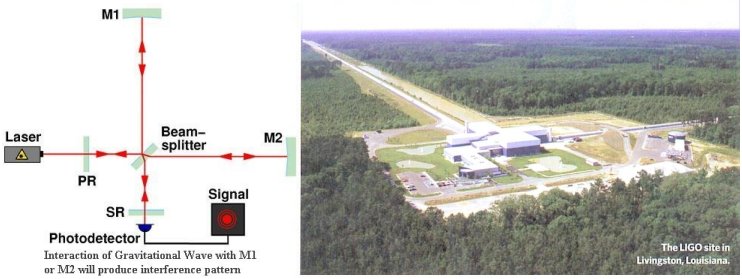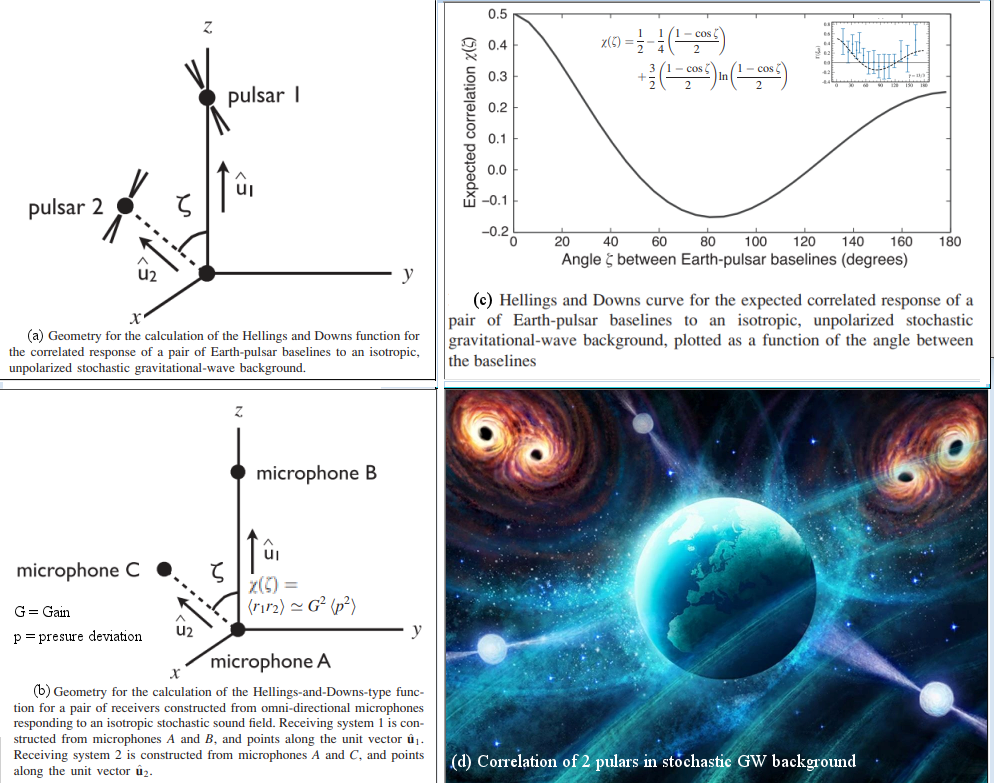
| Home Page | Overview | Site Map | Index | Appendix | Illustration | About | Contact | Update | FAQ |

 is the d'Alembertian operator in four-
is the d'Alembertian operator in four-
 |
dimensional space-time. This equation looks similar to the electromagnetic wave equation except that it is now a second rank tensor field (with 10 components) instead of the more familiar vector field. It is responsible for many different characteristics in these two kinds of field. Figure 10v shows the differences in polarization and radiation pattern. There are two polarization states in gravitational wave. They alternatively squeeze and stretch the interacting particles shown as white circle in the diagrams (with direction of propagation perpendicular to the viewing page). Table 04 compares the properties of these two kinds of wave. |
Figure 10v EW and GW | See "Discovery of Gravitational Wave" in September 2015. |
| Property | Electromagnetic Wave | Gravitational Wave |
|---|---|---|
| Field | Vector | Second Rank Tensor |
| Wave | Transversal | Transversal |
| Polarization | One State | Two States |
| Radiation Pattern | Dipole | Quadrupole |
| Source | Accelerating Charge | Accelerating Mass-Energy |
| Interaction | With Charges | With Mass-Energy |
| Quantum Particle | Spin 1 Photon | Spin 2 Graviton |
| Rest Mass | Massless | Massless |
 |
Gravitational wave have never been observed because of low radiation power and weak interaction strength. A rod about 1 meter long spun at the verge of breaking would radiate perhaps 10-30 erg/sec. The cross section for the interaction between gravitational wave of ~ 104 cycles/sec and an ammonia molecule is roughly 10-60 cm2. Figure 10w is the schematics of a gravitational wave bar detector. The impinging gravitational wave excites the fundamental longitudinal resonance (at ~ 1000 Hz) of the bar, kept at low temperatures. The induced vibration of the bar end face is amplified mechanically by the resonant transducer, which also converts the signal into an electromagnetic one. |
Figure 10w GW Detector |
The signal is then amplified and acquired (see Figure 10w). It is suggested that large-scale astronomical motions of matter could generate appreciable gravitational energy flux. |
 |
The binary pulsar PSR1913+16 was discovered in 1975. This system consists of two compact neutron stars orbiting each other with a maximum separation of only one solar radius. The rapid motion means that the orbital period of this system should decrease on a much shorter time scale because of the emission of a strong gravitational wave. The change predicted by general relativity is in excellent agreement with observations as shown in Figure 10x. Thus, the observation indirectly confirms the |
Figure 10x GW from Binary Pulsars [view large image] | phenomena of gravitational radiation. |
 |
Figure 10y illustrates the merger of two orbiting black holes. Initially, the gravitational signals from such an event would show oscillation with increasing amplitude and decreasing wavelength as the black holes spiral toward each other. A chaotic pattern of gravitational waves may be given off at the moment of merger. Finally, the resultant single black hole is expected to "ring", creating waves with diminished amplitude. This event will emit no x-ray burst, not even a flash of light. |
Figure 10y Black Hole Merger |
 |
Another model, rooted in string theory, envisions a scenario in which the Big Bang occurred as a result of the collision between two parallel universes floating in higher dimensional space. Each of these models predicts a specific pattern of gravitational waves emitted from the Big Bang. NASA and ESA plan to launch the Laser Interferometer Space Antenna (LISA) to detect gravitational wave by 2015. It consists of three satellites orbiting the sun (Figure 10za). They will be linked by three laser beams, forming a triangle of light. They are designed to detect a change in their spacing as small as 1/10 the diameter of an atom. With such sensitivity LISA might be able to detect gravitational waves created immediately after the birth of the cosmos. It offers a chance to select between the contesting cosmological models, and also provides an opportunity to test the string theory. |
Figure 10za LISA |
 |
 |
one at Livingston, Louisiana (Figure 10zb). Virgo is a 3-km interferometer at Italy. They have not yet detected the elusive gravitational wave, but managed to place an upper bound on the SGWB in the frequency band df around the frequency f ~ 100 Hz. The SGWB is defined by the formula: GW = (f / GW = (f /  c) (d c) (d GW / df) GW / df) |
Figure 10zb LIGO |
Figure 10zc SGWB |
where  GW is the energy density of gravitational radiation contained in the frequency range df, and GW is the energy density of gravitational radiation contained in the frequency range df, and  c is the critical energy density of the Universe. c is the critical energy density of the Universe. |
 GW < 6.9 x 10-6. The new data rule out models of early Universe evolution with relatively large equation of state parameter, as well as cosmic (super)string models with relatively small string tension. Improved measurements will constrain other cosmological models such as the pre-Big-Bang model, which makes testable predictions of the gravitational wave spectrum as shown by the green curve in Figure 10zc (see a novel explanation for the noise from another observation).
GW < 6.9 x 10-6. The new data rule out models of early Universe evolution with relatively large equation of state parameter, as well as cosmic (super)string models with relatively small string tension. Improved measurements will constrain other cosmological models such as the pre-Big-Bang model, which makes testable predictions of the gravitational wave spectrum as shown by the green curve in Figure 10zc (see a novel explanation for the noise from another observation). |
 |
A novel method to detect gravitational wave is to measure the number of pulses per unit time from a pulsar. Since the gravitational wave stretches and compressed space, the arrival time of the pulses will be later and sooner correspondingly (Figure 10zd). In practice, though, the present technology is not sensitive enough to detect the minuscule changes. A cunning workaround is to map out millisecond pulsars in the sky and time their pulses for long enough to find out the average time it takes them to reach Earth, any deviation in that time would indicate interference from gravitational waves. A positive map will show a pattern of variation in many pulses, all fitting the expected stretch-squeeze template. |
Figure 10zd Pulsar Beacons [view large image] |
Figure 10ze Gwave Sources and Detectors |
 |
The 2023 research reports indicate that the universe may submerge in a "sea" of stochastic (noisy) gravitational waves (GWs). The hints come from the detections of pairs of pulsars. In the presence of stochastic GWs, the two members in these pairs would follow the correlation See "Understanding the gravitational-wave Hellings and Downs curve" and an observational report : "Evidence for a Gravitational-wave Background". |
Figure 10ze2 Stochastic GW |
 |
 |
On April 8, 2011, NASA announced that it would likely be unable to continue its LISA partnership with the European Space Agency, due to funding limitations. ESA began a full revision of the mission's concept and renamed it as the New (or Next) Gravitational-wave Observatory (NGO). A cheaper detector called "Atom Interferometer" has been proposed as the replacement. It uses atomic clouds (with the associated matter waves) instead of laser as the interfering medium, whereas the laser interferometer requires two or three long base lines (in the order of few kilometers) for gravitational wave detection via the change of those arms, the atom interferometer detects the changing space in between the clouds, which is typically at a separation about 5000 times shorter than the LISA design, and |
Figure 10zf Gravity Wave Detection |
Figure 10zg Atom Interferometer |
thus reduces the cost of construction. Actually, the researchers estimate such a mission would cost between $100 million and 1 billion - not a bargain, but still significantly cheaper. |
 = h/mv, where
= h/mv, where  is the wavelength, v the velocity of the particle with mass m, and h the Planck constant.
is the wavelength, v the velocity of the particle with mass m, and h the Planck constant. c ~ 8). Significance of the GW150914 event is about 5
c ~ 8). Significance of the GW150914 event is about 5 (same as the
(same as the
 |
 |
discovery of the Higgs). Further analyse of the data reveals that the gravitational wave pattern closely matches the one from the predicted merging of two black holes (Figure 10zi, notice the increase in frequency as they merged). The same figure also show the separation (in unit of Schwarzschild radius Rs=2GM/c2, and relative velocity v/c=(GM f)/c3, where f is the gravitational-wave frequency, M the total mass). The source is about 1.4 billion light years from Earth with initial masses 36Msun, 29Msun respectively, and final mass 62Msun - less than 3Msun of mass (about 5%) had been converted to gravitational wave. The insert in f)/c3, where f is the gravitational-wave frequency, M the total mass). The source is about 1.4 billion light years from Earth with initial masses 36Msun, 29Msun respectively, and final mass 62Msun - less than 3Msun of mass (about 5%) had been converted to gravitational wave. The insert in
|
Figure 10zh GW150914 Detection |
Figure 10zi GW150914 BHs Merger |
Figure 10zh shows the estimated position of GW150914. The colored contours denote the degree of confidence from 10% to 90% at the outer-most. |
 |
 |
Gravitational wave has now been detected the 4th time by LIGO/VIRGO on August 2017, and hence the designation GW170814 (See Nature News in "European detector spots its first gravitational wave"). The initial masses of the merging black holes are 31 Msun and 25 Msun at a distance of 1.8 Bly and in the general direction of the Magellanic Clouds, which reveals that the location of this event is very close to GW150914 (Figure 10zj taken from "GW170814 Interactive Skymap"). Figure 10zk is another view to show the increasing accuracy for locating the GW170814 events with (a) LIGO Livingston (L1) and Hanford (H1) only, (b) the combination of L1, H1 and V1 (the VIRGO new addition), and (c) the refined plot. |
Figure 10zj Gwaves from Magellan |
Figure 10zk |
See a map of the four GW events --  [click to enlarge] [click to enlarge] |
 |
 |
A few days later on August 17, 2017, the LIGO/VIRGO collabration detected another gravitational wave event now denoted as GW170817. Further observations by the Fermi Gamma-ray space telescope and some seventy X-ray, optical and radio telescopes reveal that the source of GW170817 is in NGC4993 (see constellation chart in Figure 10zl) and likely to be the merger of two neutron stars (forming a black hole, Figure 10zm) in that galaxy 0.13 Bly away. |
Figure 10zl NGC4993, Sky Chart Location |
Figure 10zm NS Merger, Artist's Rendition |
Evidences include : |
 |
 |
Figure 10zn GW170817 [view large image]
|
It provides a general direction of the source on the celestial sphere (Figure 10zn).  |
 |
  |
Figure 10zo Map of 5 GW Events [view large image] |
Figure 10zo shows the locations of the 5 GW events. |